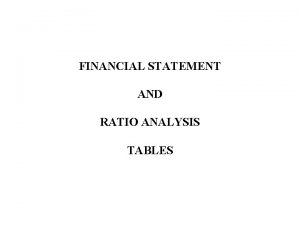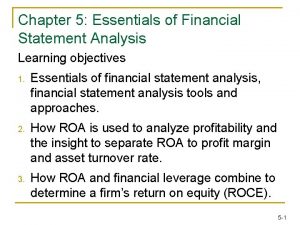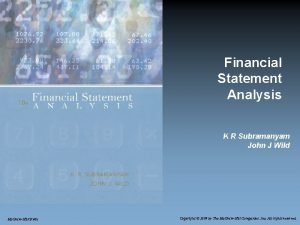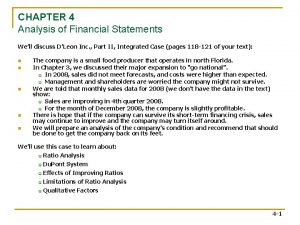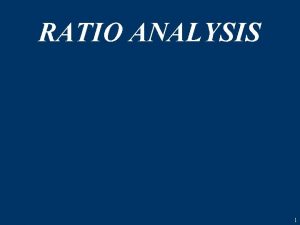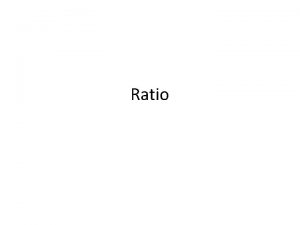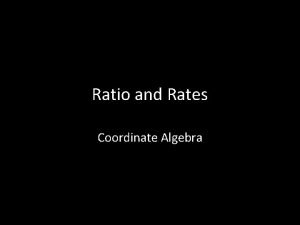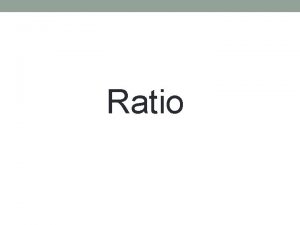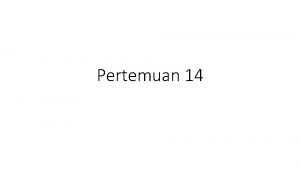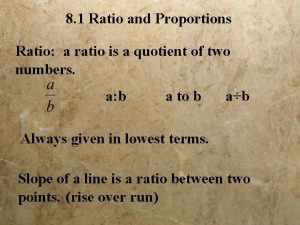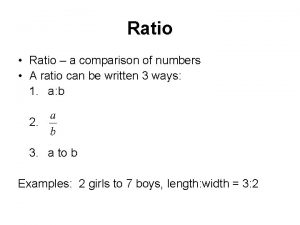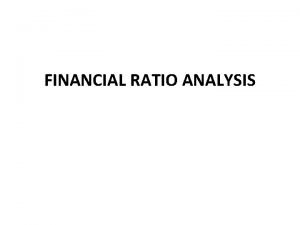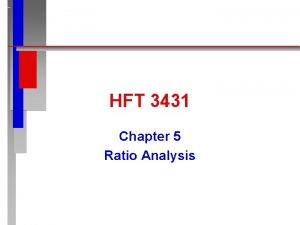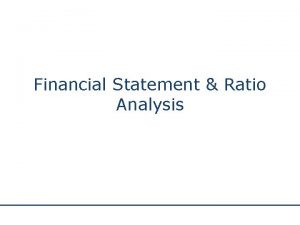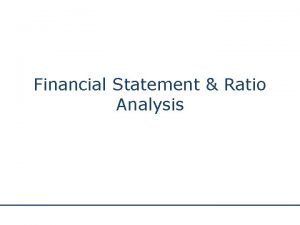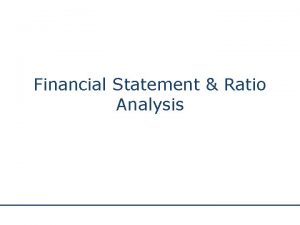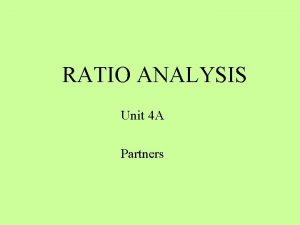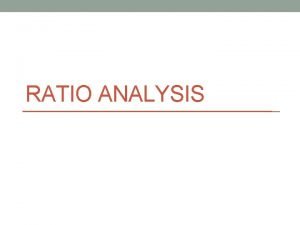Financial Analysis Chapter 3 z Ratio Analysis y


















- Slides: 18

Financial Analysis (Chapter 3) z Ratio Analysis y. Liquidity y. Asset Utilization y. Debt Utilization y. Profitability y. Market Value z Du. Pont Relationships z Ratio Analysis and Wealth Maximization z Some Analytical Problems

RATIO ANALYSIS z. Ratio Defined: y. Simply one number divided by another. z. Why Calculate Ratios? y. Make data more meaningful. z. High - Low - Avg: How do you judge? y. Industry Averages: x. Dun & Bradstreet x. Robert Morris Associates x. Trade Associations

Ratio Analysis (Continued) y. Prior Period Ratios: x. Calculated from the firm’s previous financial statements (e. g. , trend analysis) y. Current Goals: x. Often, goals are stated in the form of ratios. y. Benchmarking: x. A group of “selected” companies (e. g. , form your own industry).

Common Size Ratios z Common Size Balance Sheet y. Each item is stated as a % of total assets. z Common Size Income Statement y. Each item is stated as a % of sales.

Liquidity Ratios z Liquidity Ratios: y. Ability to meet short-term obligations

Asset Utilization Ratios Effective use of assets in the process of generating sales. z. Receivables Ratios y. Note: Ideally, credit sales should be used for the receivables ratios. However, only total sales are available at times. AKA: Days Sales Outstanding

Asset Utilization Ratios (Continued) z. Inventory Turnover Note: COGS is sometimes used in lieu of sales, and average inventories may replace ending inventories.

Asset Utilization Ratios (Continued) z. Asset Turnover Ratios y. Note: Net fixed assets equals gross fixed assets minus accumulated depreciation.

Debt Utilization Ratios (Use of Financial Leverage) z. Leverage Ratios:

Debt Utilization Ratios (Continued) z. Fixed Charge Coverage Ratio* *Could also be adjusted to include principal payments on loans.

Profitability Ratios (Ability to Earn an Adequate Return) z. Profit Margins:

Profitability Ratios (Continued) z. Return on Investment Ratios: AKA: ROI

Du. Pont Relationships (ROA)

Market Value Ratios (Investors’ Reactions) z Notes: (1) Book Value Per Share = (Com Equity)/(# of Shares) (2) Cash flow per share equals net income plus depreciation or amortization divided by the number of shares outstanding.

Ratio Analysis and Wealth Maximization Expenses Net Profit Margin Return on Assets Sales Total Asset Turnover Assets Debt to Assets Ratio Return on Total Equity Preferred Stock Financing Return on Common Equity

Ratio Analysis and Wealth Maximization (Continued) Return on Common Equity Earnings Per Share X X Book Value Per Share Price Earnings Ratio = = Earnings Per Share Price Per Share

Some Analytical Problems Involving Asset Quality z It is possible to increase ROI by avoiding the purchase of new plant and equipment (i. e. , keep the asset base low). Of course, the firm may suffer in the long run. z A high level of accounts receivable may improve the current ratio, but what if a large percentage of accounts are uncollectible?

Some Additional Analytical Problems z. Inflation y. Sales and profits may increase simply because of rising prices, even without an increase in physical volume. y. Replacement costs of assets may be higher than historical costs. z. Inventory Accounting y. If firms employ different techniques (e. g. , LIFO, FIFO), comparability of ratios is impaired. z. Industry Averages y. Some firms operate in more than one.
 Financial statements and ratio analysis chapter 3
Financial statements and ratio analysis chapter 3 How to improve current ratio
How to improve current ratio Boeing balance sheet analysis
Boeing balance sheet analysis Financial ratio analysis
Financial ratio analysis Hazard ratio vs odds ratio
Hazard ratio vs odds ratio Velocity ratio vs gear ratio
Velocity ratio vs gear ratio Acid test ratio and quick ratio
Acid test ratio and quick ratio Variable interval positive reinforcement
Variable interval positive reinforcement Phenotypic ratio in dihybrid cross
Phenotypic ratio in dihybrid cross Ukuran asosiasi statistika
Ukuran asosiasi statistika Current ratio and quick ratio
Current ratio and quick ratio Financial interrelation ratio
Financial interrelation ratio Financial ratio classification
Financial ratio classification Types of ratios
Types of ratios Non financial method of motivation
Non financial method of motivation Summary of ratio analysis
Summary of ratio analysis Subramanyam financial statement analysis
Subramanyam financial statement analysis Chapter 14 financial statement analysis solutions
Chapter 14 financial statement analysis solutions Chapter 4 analysis of financial statements
Chapter 4 analysis of financial statements


